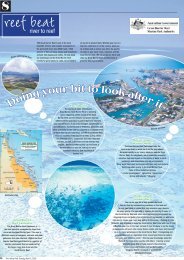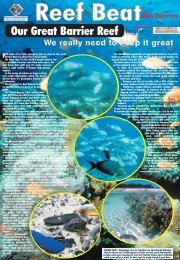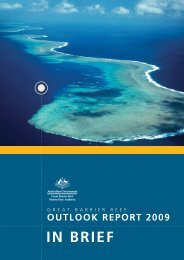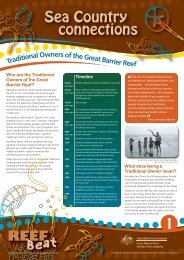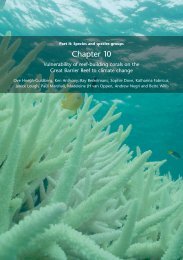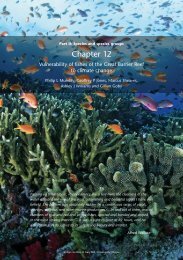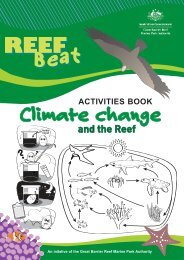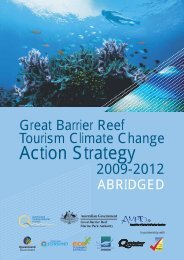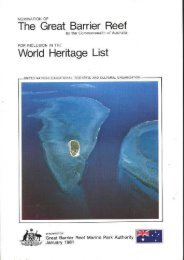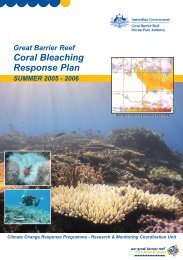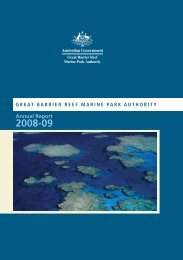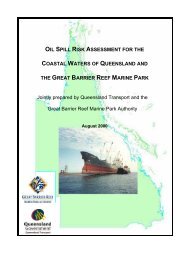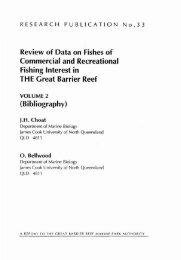Chapter 1: Introduction to the Great Barrier Reef and climate change
Chapter 1: Introduction to the Great Barrier Reef and climate change
Chapter 1: Introduction to the Great Barrier Reef and climate change
Create successful ePaper yourself
Turn your PDF publications into a flip-book with our unique Google optimized e-Paper software.
1.2.1 The ecosystem<br />
The <strong>Great</strong> <strong>Barrier</strong> <strong>Reef</strong> Marine Park is almost 350,000 square kilometres in area. This makes it larger<br />
than <strong>the</strong> combined area of <strong>the</strong> Australian states of Vic<strong>to</strong>ria <strong>and</strong> Tasmania. It is also larger than <strong>the</strong><br />
United Kingdom, Malaysia <strong>and</strong> many o<strong>the</strong>r countries. It spans 14 degrees of latitude <strong>and</strong> is located<br />
along 2100 kilometres of <strong>the</strong> coastline of Queensl<strong>and</strong> in nor<strong>the</strong>ast Australia.<br />
Most people think of <strong>the</strong> <strong>Great</strong> <strong>Barrier</strong> <strong>Reef</strong> as an enormous single coral reef. In truth, <strong>the</strong>re is a<br />
complex maze of about 2900 separate coral reefs. However, <strong>the</strong>se reefs account for only about<br />
6 percent of <strong>the</strong> area of <strong>the</strong> <strong>Great</strong> <strong>Barrier</strong> <strong>Reef</strong> Marine Park. About 36 percent of <strong>the</strong> <strong>Great</strong> <strong>Barrier</strong><br />
<strong>Reef</strong> Marine Park is continental slope, where <strong>the</strong> water is between 150 <strong>and</strong> 2000 metres deep. The<br />
remaining 64 percent is continental shelf, including <strong>the</strong> coral reefs, which is anywhere from 1 <strong>to</strong> 150<br />
metres deep. The o<strong>the</strong>r main geographical components of <strong>the</strong> continental shelf are <strong>the</strong> inter-reef<br />
areas (25% of <strong>the</strong> Marine Park) <strong>and</strong> <strong>the</strong> lagoon (33%). The vast majority of <strong>the</strong> coral reefs are found<br />
relatively far offshore with <strong>the</strong> inshore lagoon having few reefs (Figure 1.1).<br />
Within <strong>the</strong>se major geographic divisions of <strong>the</strong> <strong>Great</strong> <strong>Barrier</strong> <strong>Reef</strong> are many different types of habitat<br />
<strong>and</strong> biological community. The best known of <strong>the</strong>se are <strong>the</strong> coral reefs, but <strong>the</strong>re are also seagrass<br />
beds, algal meadows, sponge <strong>and</strong> soft coral gardens, s<strong>and</strong>y <strong>and</strong> muddy areas, mangrove forests <strong>and</strong><br />
isl<strong>and</strong>s. This array of habitats supports an amazing biodiversity. The <strong>Great</strong> <strong>Barrier</strong> <strong>Reef</strong> is home <strong>to</strong><br />
about 1500 species of fish, 350 species of hard coral, more than 4000 species of mollusc, 500 species<br />
of algae, 6 of <strong>the</strong> world’s 7 species of marine turtle, 24 species of seabird, more than 30 species of<br />
whale <strong>and</strong> dolphin <strong>and</strong> <strong>the</strong> dugong. And <strong>the</strong>se are just <strong>the</strong> species that have been recorded so far. As<br />
biodiversity surveys continue, more species new <strong>to</strong> <strong>the</strong> <strong>Great</strong> <strong>Barrier</strong> <strong>Reef</strong> <strong>and</strong> sometimes even new<br />
<strong>to</strong> science are being discovered.<br />
The <strong>Great</strong> <strong>Barrier</strong> <strong>Reef</strong> is often heralded as one of <strong>the</strong> world’s best-studied tropical marine ecosystems.<br />
Indeed, <strong>the</strong> coral reefs have been intensively studied since <strong>the</strong> first formal scientific expedition <strong>to</strong> <strong>the</strong><br />
<strong>Great</strong> <strong>Barrier</strong> <strong>Reef</strong> in 1928. Despite this, our underst<strong>and</strong>ing of even coral reefs is incomplete. This<br />
is unsurprising given that <strong>the</strong> 2900 coral reefs cover 21,000 square kilometres <strong>and</strong> are spread out<br />
through much of <strong>the</strong> <strong>Great</strong> <strong>Barrier</strong> <strong>Reef</strong>. Moreover, our underst<strong>and</strong>ing of <strong>the</strong> o<strong>the</strong>r major components<br />
of <strong>the</strong> <strong>Great</strong> <strong>Barrier</strong> <strong>Reef</strong> is even less developed. Recent research has begun <strong>to</strong> unlock <strong>the</strong> secrets<br />
of <strong>the</strong> inter-reef <strong>and</strong> lagoon areas by documenting <strong>and</strong> mapping <strong>the</strong>ir biodiversity. However, <strong>the</strong><br />
continental slope remains an almost complete mystery. In 1990 a trawler brought up a species of<br />
crayfish from <strong>the</strong> continental slope that had never before been encountered in Australian waters. The<br />
continental slope is up <strong>to</strong> 2000 metres deep, presenting a logistical challenge that has discouraged<br />
serious research in <strong>the</strong> area.<br />
Part I: <strong>Introduction</strong><br />
<strong>Chapter</strong> 1: <strong>Introduction</strong> <strong>to</strong> <strong>the</strong> <strong>Great</strong> <strong>Barrier</strong> <strong>Reef</strong> <strong>and</strong> <strong>climate</strong> <strong>change</strong><br />
Despite a great deal of research, <strong>the</strong> <strong>Great</strong> <strong>Barrier</strong> <strong>Reef</strong> ecosystem <strong>and</strong> its biodiversity are far from fully<br />
unders<strong>to</strong>od. We do not have a complete inven<strong>to</strong>ry of <strong>the</strong> species in <strong>the</strong> <strong>Great</strong> <strong>Barrier</strong> <strong>Reef</strong>, let alone<br />
maps of species distributions or complete accounts of <strong>the</strong>ir ecology. Never<strong>the</strong>less <strong>the</strong>re is a great deal<br />
that is known <strong>and</strong> this book draws on that knowledge <strong>to</strong> assess <strong>the</strong> vulnerability of <strong>Great</strong> <strong>Barrier</strong> <strong>Reef</strong><br />
species, habitats <strong>and</strong> processes <strong>to</strong> <strong>climate</strong> <strong>change</strong>.<br />
Climate Change <strong>and</strong> <strong>the</strong> <strong>Great</strong> <strong>Barrier</strong> <strong>Reef</strong>: A Vulnerability Assessment



